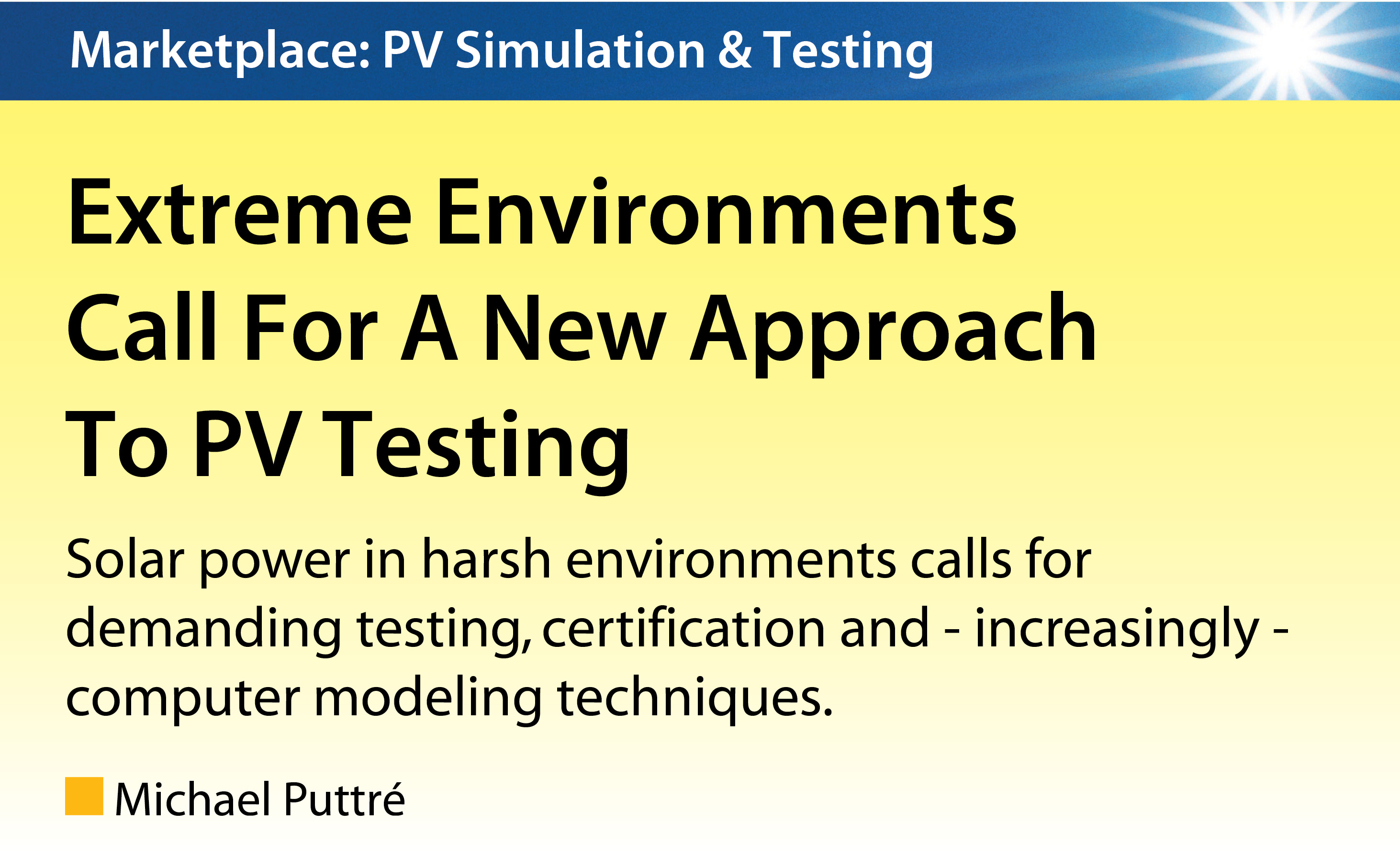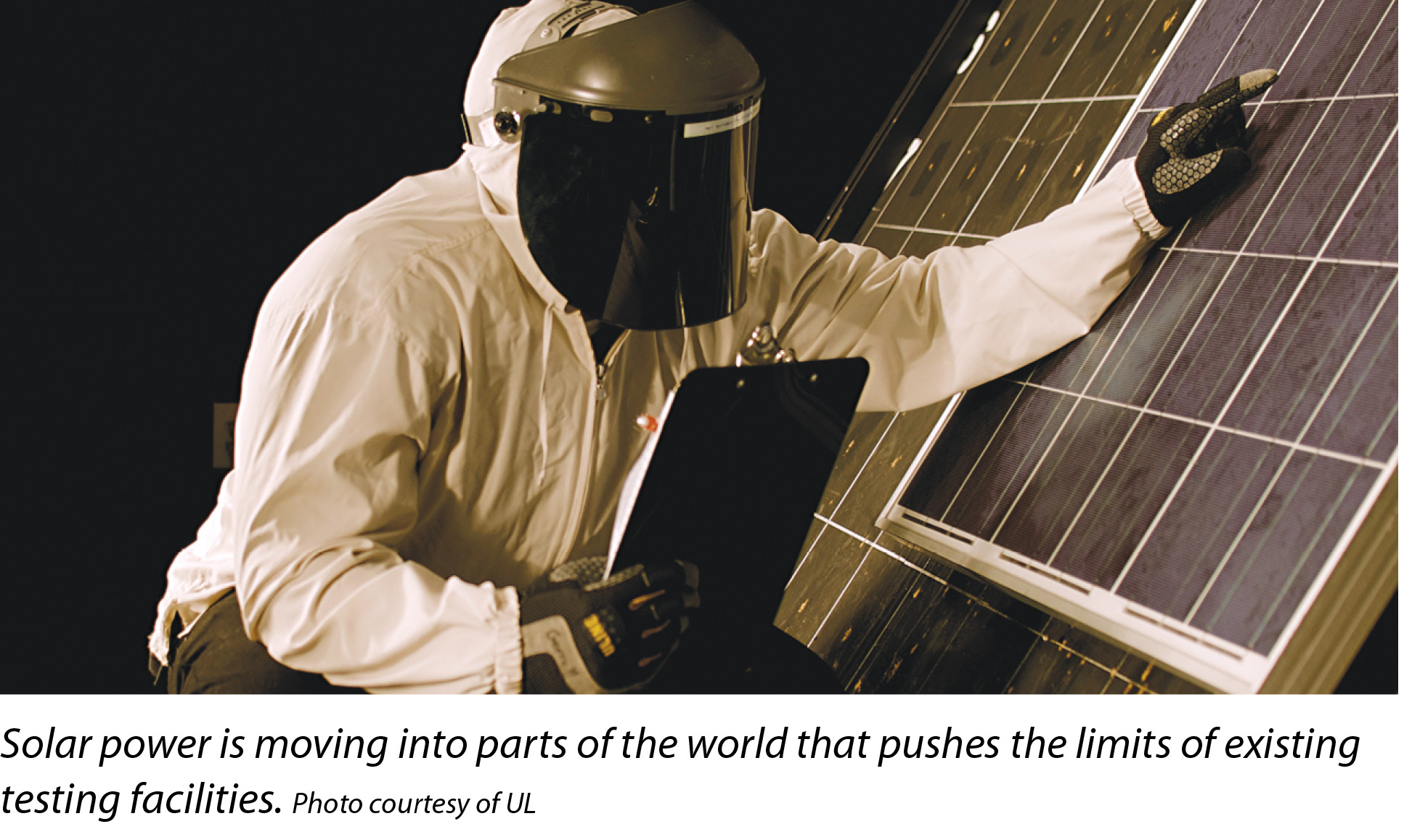

301 Moved Permanently
Last December, with singular timing, the Center for the Evaluation of Clean Energy Technology Inc. (CECET) opened its new PV Certification Testing Lab in Cortland, N.Y. The New York State Energy Research and Development Authority (NYSERDA) provided a portion of the funding for the center, which, among its other functions, will study the impacts of snow, extreme temperature and adverse weather conditions on photovoltaic power systems.
“NYSERDA has recognized the need for testing in this climate, and this winter is proving that it was a good decision,” says Richard Lewandowski, executive director of CECET, a wholly owned subsidiary of Intertek.
Lewandowski points out that the establishment of a new testing facility in upstate New York comes at a time when the northeastern U.S. is experiencing a boom in demand for solar power.
The move of PV systems into extreme environments is a worldwide trend. Evelyn Butler, global director for energy for Underwriters Laboratories Inc. (UL), says her company is seeing increasing demand for its testing and certification services for PV systems intended for harsh climates on an international basis.
The company opened its first dedicated PV testing facility in California in 2008. Within two and a half years, it had four more PV labs - in Germany, India, Japan and China.
“Having five dedicated labs for a single industry segment is very unusual for the company,” Butler says, adding testament to the explosive growth of solar power.
UL publishes standards for U.S. and international ratings. According to Butler, testing requests for international applications have tended to have requirements for harsher conditions for humidity, freezing cycles and wind loads. This reflects the more extreme environments PV plants are expected to operate in.
In particular, Butler says there have been more requests for dust testing. Such requests are indicative of barren locations - not just deserts - where plants may need to function with minimal personnel available on site for operations and maintenance (O&M).
Other common requests include ammonia testing, which is a requirement for PV plants operating in agricultural areas that may be exposed to pesticides and fertilizer. Tests in corrosive maritime environments are in demand.
One of the challenges with testing for extreme environments is that the requested parameters often bump up against the limitations of a lab’s testing equipment. If a client wants a test that runs 105% beyond the test equipment’s rated performance, it becomes necessary to turn to modeling and extrapolation.
More important than the physical parameters of the tests is the time involved to conduct them. The common thermocycle test, for example, runs a heat-freeze cycle 200 times. A so-called thermo 200 test can take 42 days. Demand for thermo 200 testing of PV equipment is so great that there are wait times of over a year, even with five labs.
“Our biggest issue is time, not equipment,” Butler says. “For this reason, modeling is very interesting to us.”

Butler says UL is interested in employing computer-aided engineering tools to model PV components and systems - both as a means for simulating extreme environments and for reducing the time it takes to complete a testing regime.
“Computer modeling offers us an opportunity to test beyond the current standards,” she says.
The PV industry is still relatively young in that the products fueling today’s explosive growth are, by and large, at the early stages of their operational lives, which may run 20 years or more. This means practical information about the long-term effects of different environments on PV systems is not available.
Butler says one way to approach developing applicable models is to look at materials testing for industries with a long track record. The automotive industry, for example, has a wealth of information about the effects of exposure on materials used in cars. Some of these materials, such as a polymers, composites, outdoor paint and rust treatment, have similar properties to materials used in PV panels and power plant systems.
“The question is, how do we make those connections?” Butler says. “More than anything, we need to validate the models. Have we created a model that is applicable?”
UL’s evolving work in the solar sector is providing opportunities to acquire the first-hand information software engineers need to create accurate computer models. As PV installations age, Butler says, clients are asking UL to perform on-site inspections.
“Developers will ask us to do visual inspection of the modules on-site, looking for physical degradation,” she says.
The reason is that plant owners are focused on their returns on investment and need to plan for adding solar panels or other components to ensure productivity.
CECET’s Lewandowski says his organization is looking at performing field testing for clients with a new mobile test lab. The goal here is to enable testing of products that are being installed, and also products and components that have already been in the field for some length of time.
“This can provide significantly better data than simulated tests,” he says.
Lewandowski expects the mobile field lab service to be available later this year.
According to Butler, the competitiveness of the solar sector has caused a shift in UL’s focus toward product development over the years, and the need to field products for harsh climates has only accelerated this. The company’s work developing models for PV systems performance can be calibrated very precisely for specific environments, which can shave months and even years off product development cycles.
“In 2008, testing and certification was 98 percent of UL’s business,” Butler says, adding that demand for research and development has grown rapidly. “Now it’s more like 50/50.”
CECET also assists clients in research and development, Lewandowski says. If the client has difficulty passing certification testing for particular environments, CECET can assist by coordinating resources to develop adaptations to satisfy standards and/or create testing protocols to demonstrate features that are not reflected in existing standards, he says.
“Knowing what is needed before you go through the expense of certification can be a real time and money saver for new companies with new products,” Lewandowski says. S
Marketplace: PV Simulation & Testing
Extreme Environments Call For A New Approach To PV Testing
By Michael Puttré
Solar power in harsh environments calls for demanding testing, certification and - increasingly - computer modeling techniques.
si body si body i si body bi si body b
si depbio
- si bullets
si sh
si subhead
pullquote
si first graph
si sh no rule
si last graph